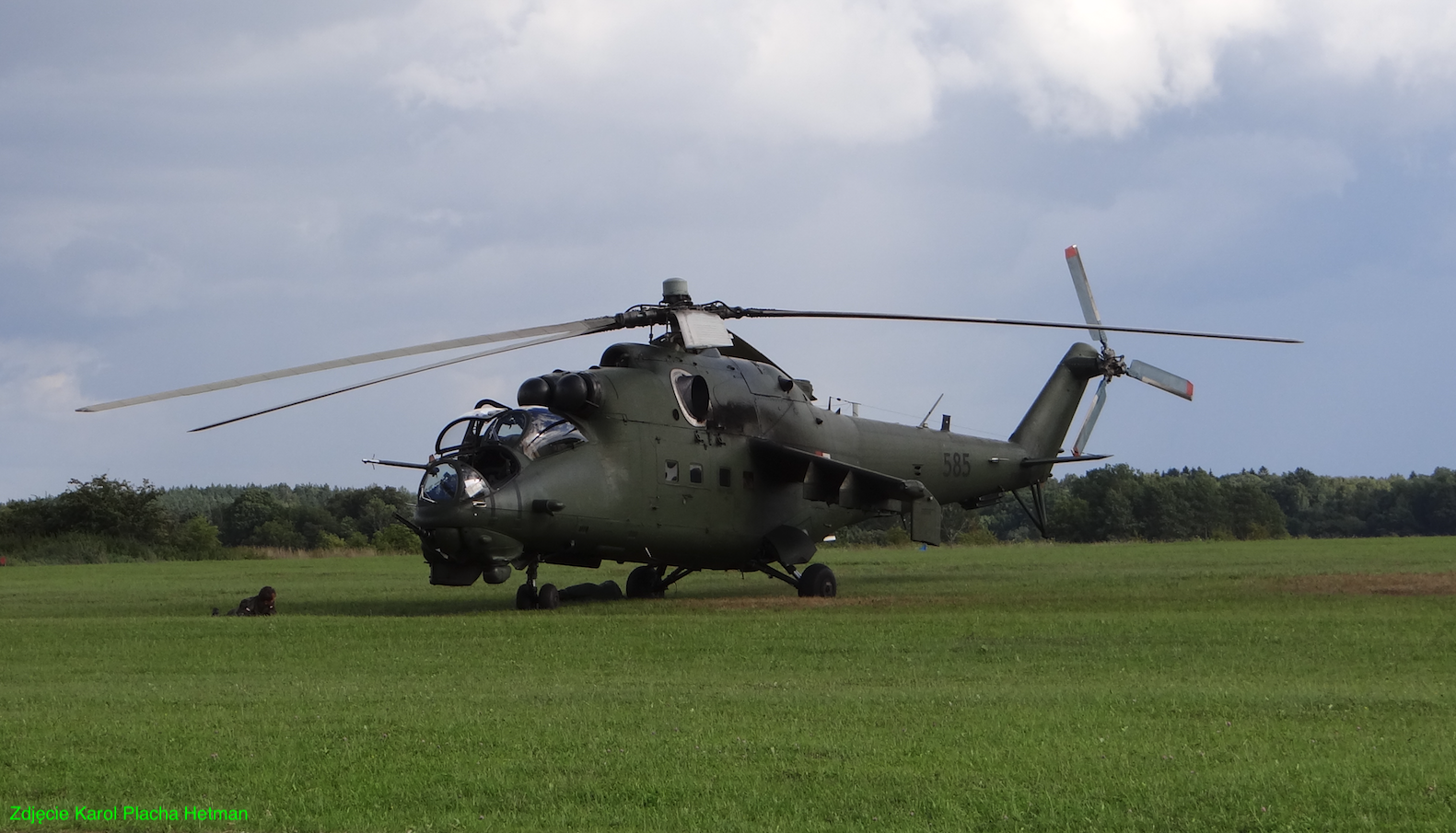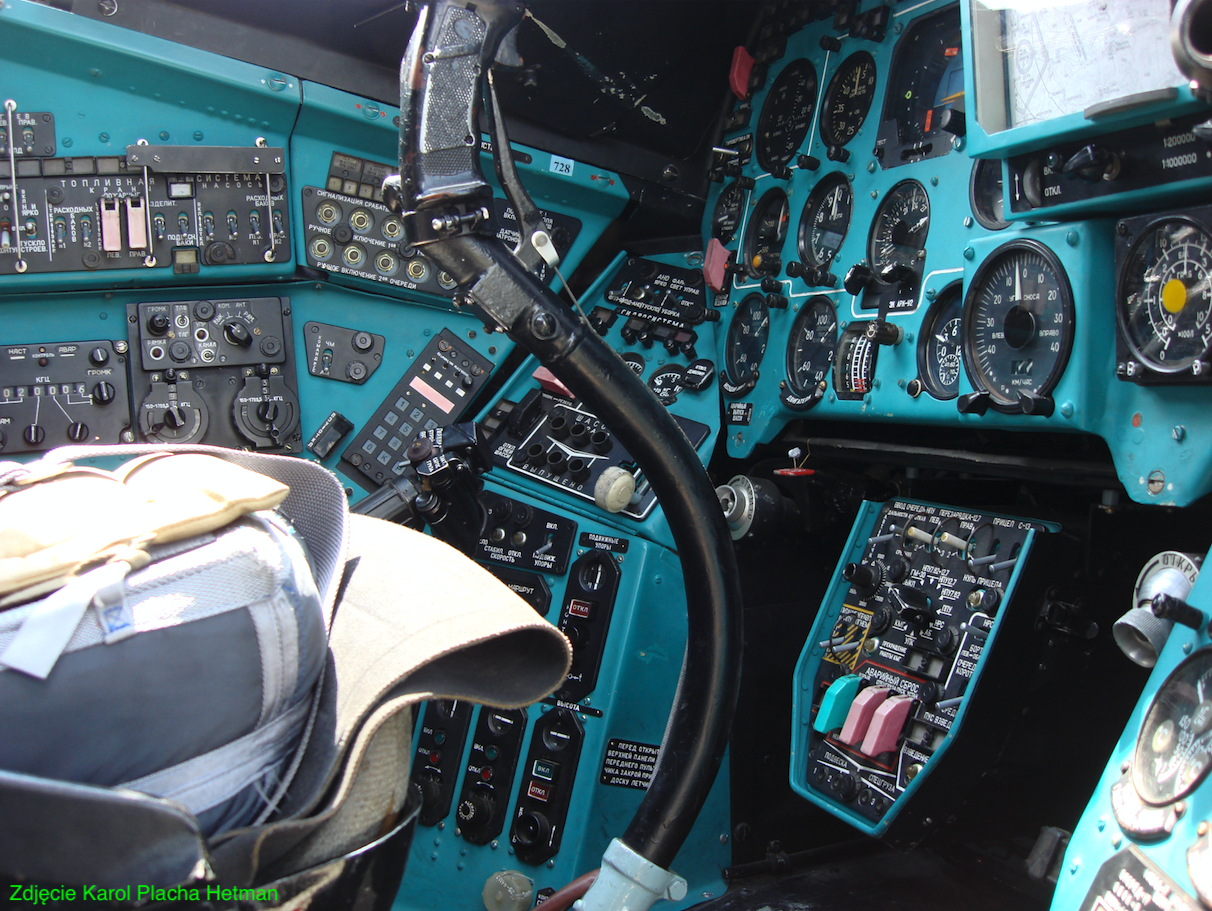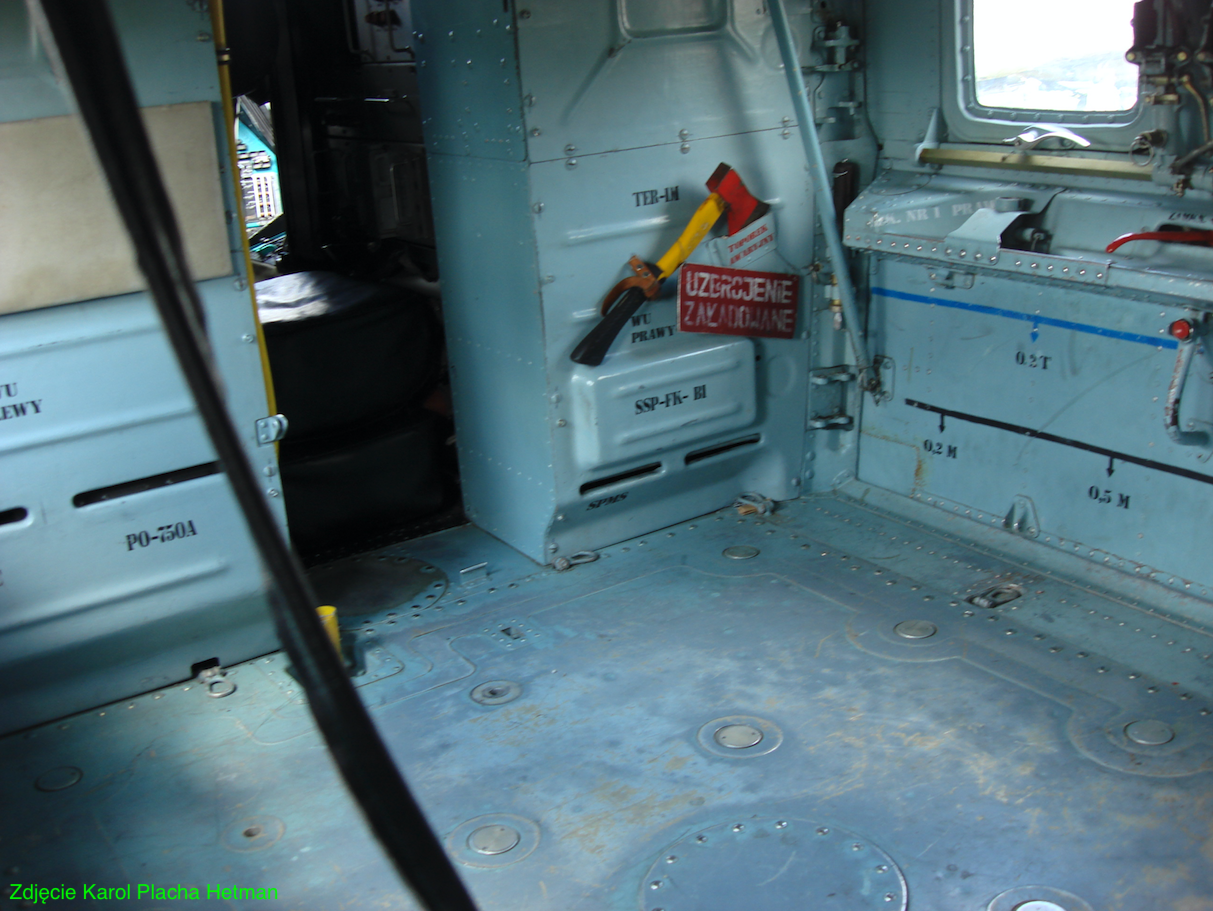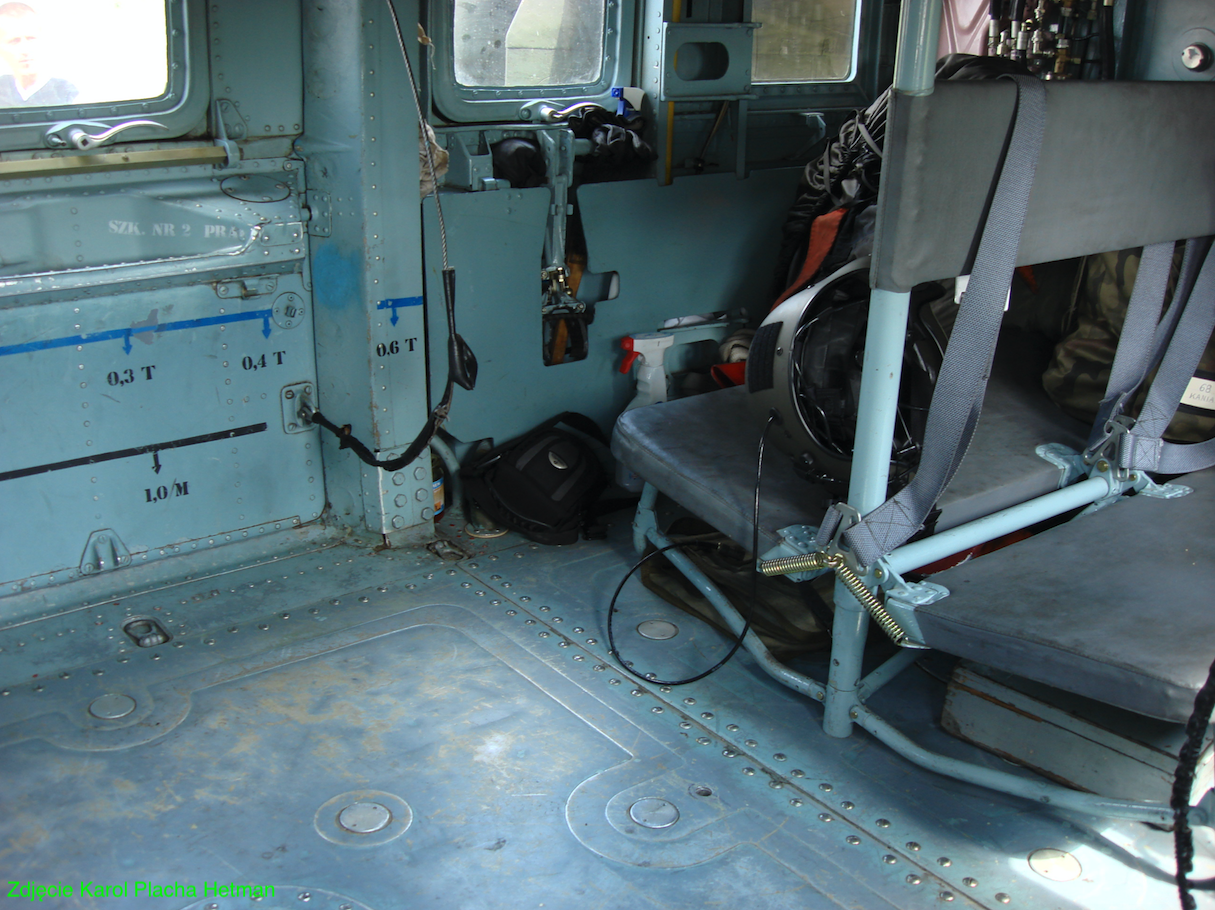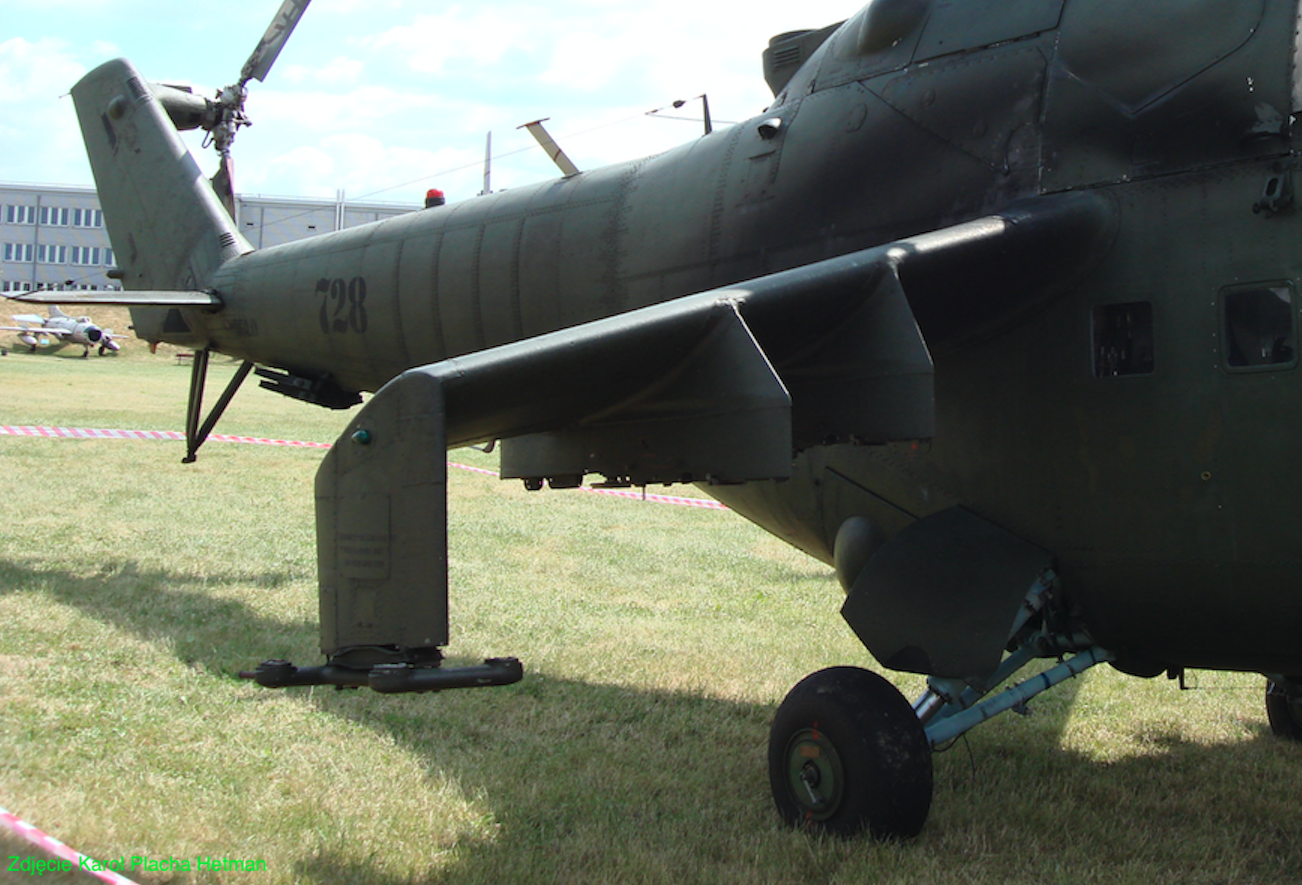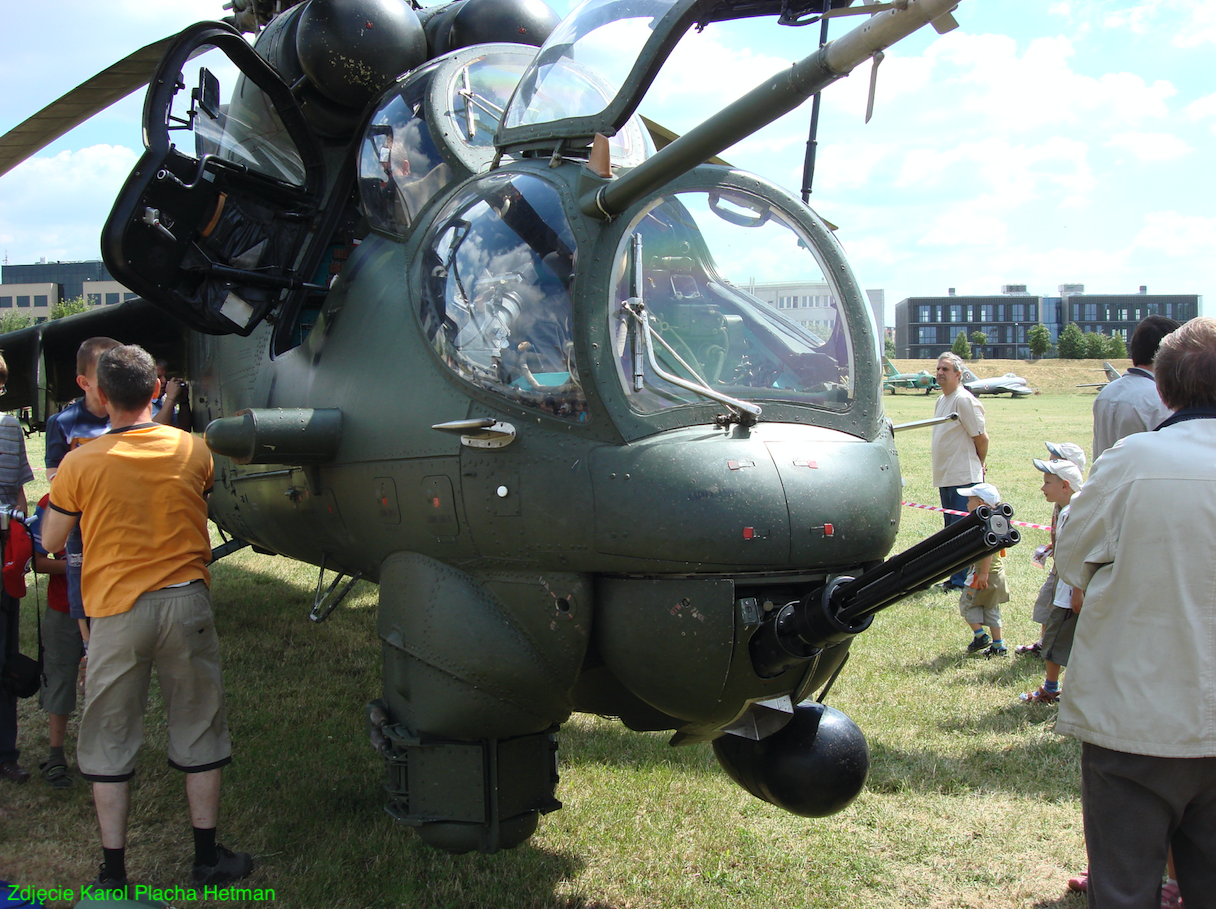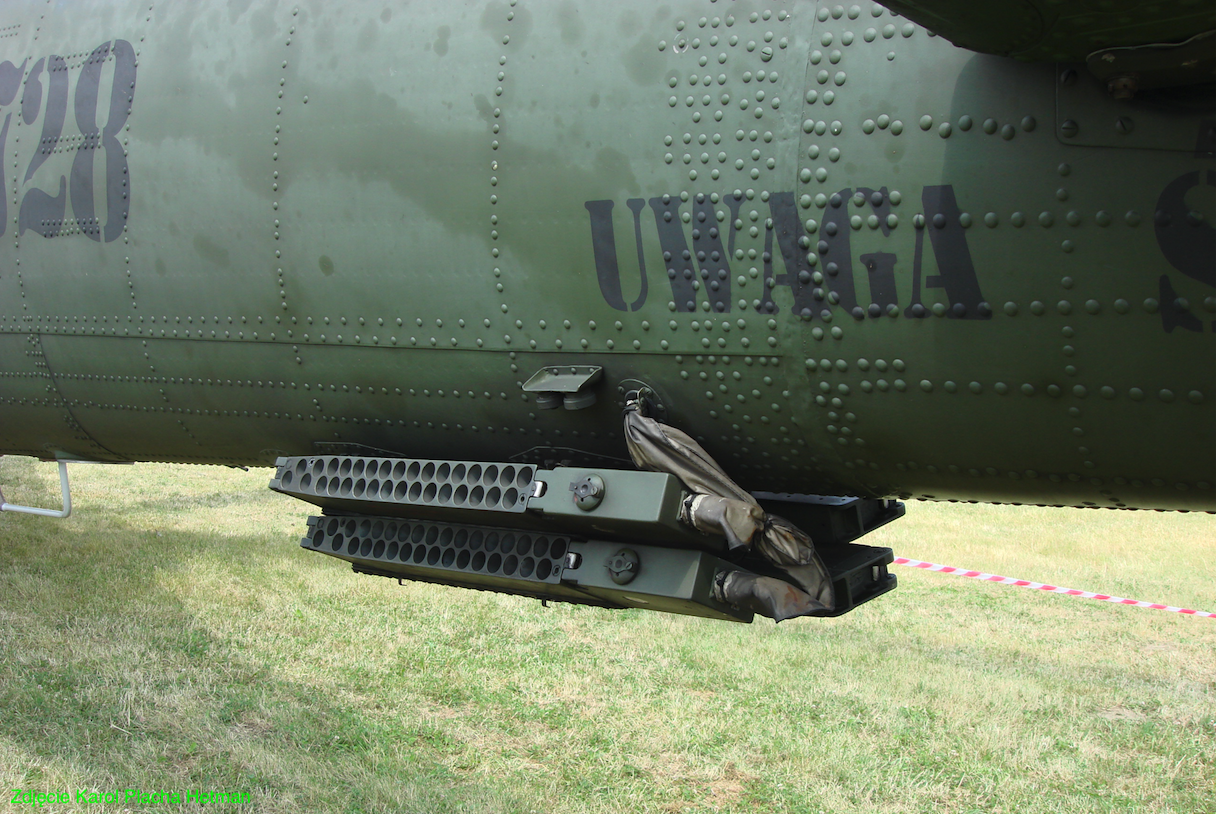Warszawa 2018-04-07
Śmigłowiec szturmowy Michaił Mil Mi-24.
Śmigłowiec Mil Mi-24 Nb 585 w malowaniu stosowanym z początkiem XXI wieku.
Konstrukcja śmigłowca Mi-24.
Mil Mi-24 jest średnim śmigłowcem szturmowo-transportowym, zbudowany w układzie klasycznym z napędem dwusilnikowym.
Wirnik główny.
Wirnik główny został zaadoptowany ze śmigłowca Mi-8, ale o zmniejszonej średnicy; Mi-8 średnica 21,29 m, Mi-24 średnica 17,00 m. Dzięki mniejszej średnicy wirnika nośnego, końcówki łopat mają mniejszą prędkość, a dzięki temu generują mniejszy hałas. Piasta wirnika wykonana jest z wysoko-wytrzymałej stali. Łopaty zawieszono przegubowo, z przegubami wahań, odchyleń i przekręceń. Przeguby odchyleń z tłumikami hydraulicznymi. Łopaty o obrysie prostokątnym mają profil NACA 230. Dźwigar główny, przedni wykonany jest z tytanu. Część spływowa wykonana z laminatu z wypełniaczem ulowym. Przy końcu łopaty zamontowano klapkę odciążającą. Na krawędzi natarcia zamontowano elektryczną instalację przeciw-oblodzeniową. Wnętrze łopat wypełniono azotem pod zwiększonym ciśnieniem. Uszkodzenie łopaty jest sygnalizowano wysunięciem specjalnego kołpaka, co sprawdza się podczas postoju śmigłowca. Każda łopata jest montowana do głowicy wirnika przy pomocy dwóch sworzni, na wielo-wpustach. Wirnik obraca się zgodnie ze wskazówkami zegara. Wirnik wyposażony jest w hamulec.
Śmigło ogonowe.
Śmigło ogonowe trój-łopatowe, także zaadaptowane ze śmigłowca Mi-8. W wersjach A, B, C umieszczone po prawej stronie belki ogonowej. W wersji D i następnych, po lewej stronie. Śmigło wykonano ze stali, aluminum i laminatów. Spływ łopaty z wypełniaczem ulowym. Na krawędzi natarcia jest elektryczna instalacja przeciw-oblodzeniowa. Śmigło obraca się zgodnie ze wskazówkami zegara.
Układ przeniesienia napędu.
Układ przeniesienia napędu opiera się na przekładni głównej. Ruch obrotowy z wolnej turbiny, z jednego i drugiego silnika jest przekazywany na podwójną przekładnię planetarną, która redukuje obroty, przemieniając je w siłę. Z przekładni głównej wychodzi główny wał wirnika nośnego oraz wał napędu śmigła ogonowego. Układ wału śmigła ogonowego ma dwie przekładnie zębate, stożkowe.
Kadłub śmigłowca.
Kadłub śmigłowca jest metalowy, półskorupowy. Głównie zastosowano duraluminium. Zbudowany z wręg, podłużnic i pokrycia. Kadłub ma pięć wręg głównych, które przenoszą największe obciążenia. Do nich mocowane są łoża silników, przekładnia główna, podwozie śmigłowca, skrzydła z belkami uzbrojenia. Niektóre, newralgiczne miejsca wzmocniono dodatkowo nakładkami wykonanymi z tytanu.
Kokpit załogi.
Mi-24 D. Kokpit umieszczono w przedzie śmigłowca. We wnętrzu umieszczono dwa fotele załogi. Pierwszy fotel zajmuje operator uzbrojenia, a tylny, z przewyższeniem pilot. Tylny fotel jest umieszczony wyżej o 0,30 m. Kokpit jest bogato oszklony. Przednie szyby wykonano ze szkła przeciw-pancernego. We wcześniejszych wersjach załoga składała się z trzech, a nawet czterech lotników (pierwsze modele i makiety). Kokpit jest hermetyczny, wentylowany oraz ogrzewany lub chłodzony. Wejście do kokpitu operatora znajduje się w lewej burcie, w wejście do kokpitu pilota znajduje się w prawej burcie.
Ładownia śmigłowca.
Kabina towarowa pozwala na zabranie ośmiu żołnierzy z pełnym ekwipunkiem lub czterech rannych na noszach. Dostęp do kabiny umożliwiają drzwi umieszczone w obu burtach. Drzwi są dwuczęściowe, otwierane: górna część do góry, dolna część do dołu. Wspomnianych ośmiu żołnierzy siedzą na dwóch ławkach, po czterech, plecami do siebie. Dzięki temu mogą prowadzić ogień poprzez otwarte drzwi kabiny. Zarówno w kabinie towarowej jak i w kokpicie załogi można utrzymywać wyższe ciśnienie niż te co jest na zewnątrz. Dzięki temu śmigłowiec może przelatywać przez strefy skażone.
Płat pomocniczy.
Płat pomocniczy służy do zwiększenia zasięgu śmigłowca i zamocowania pod nimi węzłów z uzbrojeniem podwieszanym. W locie z dużą prędkością skrzydła odciążają wirnik nośny o około 25 %. (Szczegółowo 22-28 %, w zależności od prędkości i innych warunków). Płaty mają ujemny wznos 16 stopni. Zaklinowane są pod kątem 20 stopni. Konstrukcja całkowicie metalowa. Powierzchnia 6,75 m kwadratowych. Dźwigar obu skrzydeł są połączone we wnętrzu śmigłowca, za kabiną towarową. Pod każdym skrzydłem są trzy pylony dla uzbrojenia. Wysokość poszczególnych węzłów jest taka, że obsługa uzbrojenia jest wygodna. Śmigłowiec Mi-24 B miał skrzydła proste, a po każdym tylko jeden węzeł. Węzły były umieszczone stosunkowo wysoko i obsługa była utrudniona.
Usterzenie.
Usterzenie pionowe jest odchylone w prawo o 3 stopnie. Usterzenie poziome o obrysie trapezowym, trymowane.
Podwozie.
Podwozie typu samolotowego z przednim podparciem, całkowicie chowane w kadłub. Przedni zespół z dwoma kołami na wspólnej osi, wciągane w tył. Podwozie główne z pojedynczymi kołami, chowane do tyłu z obrotem o 90 stopni. Golenie amortyzowane za pomocą amortyzatorów olejowo-powietrznych. Pneumatyki niskociśnieniowe. Dostosowane do operowania z nawierzchni gruntowej (trawiastej). Ochroną belki ogonowej jest zderzak zawieszony na konstrukcji złożonej z trzech rur.
Zespół napędowy.
Zespół napędowy złożony z dwóch silników turbinowych z tak zwaną wolną turbiną. Konstrukcji Siergieja Piotrowicza Izotowa. Początkowo używano silników TW2-117 A, o mocy max 2 x 1 267 kW, mocy startowej 2 x 1 118 kW, mocy stałej 2 x 895 kW. Nieco później zastosowano silniki TW3-117, o mocy startowej 2 x 1 620 kW, o mocy nominalnej 2 x 1 400 kW. TW2-117 A: długość 2,835 m, szerokość 0, 547 m, wysokość 0,765 m. Masa 330 kg.
Sprężarka silnika osiowa, 10-stopniowa. Pierwsze 3-stopnie regulowane. Kierownice na wlocie regulowane. Spręż sprężarki wynosi 6,6:1. Komora spalania pierścieniowa, wyposażona w 8 wtryskiwaczy i dwa zapłonniki. Turbina sprężarki 2-stopniowa. Wolna turbina także 2-stopniowa. Wylot spalin odchylony o 60 stopni w lewo lub w prawo. Silniki mają system przeciw-pompażowy. Silniki są zamienne. Wloty powietrza do silników wyposażone są w instalacje przeciw-oblodzeniową. Można na nich zamontować osłony przed dostaniem się do silników ciał obcych. Między silnikami umieszczono chwyt powietrza dla chłodzenia silników i przekładni głównej.
Śmigłowiec Mi-24 posiada pomocniczy zespół napędowy APU. Wersja D i E mają możliwość montażu na wlotach odśrodkowych filtrów przeciw-pyłowych. Natomiast na wylotach spalin można montować urządzenia redukujące ślad cieplny. Zasada działania polega na dostarczeniu w strumień spalin dodatkowej porcji zimnego, zewnętrznego powietrza i taką mieszaninę kieruje się w górę, aby wirnik nośny rozproszył ciepły ślad zupełnie. Zbiorniki paliwa: Główny zbiornik paliwa umieszczono za kabiną towarową. Pozostałe pod podłogą kabiny towarowej. Możliwe jest powieszenie dodatkowych zewnętrznych zbiorników paliwa.
Wyposażenie.
Instalacja elektryczna zdwojona, zasilana jest z akumulatorów i trzech generatorów. Śmigłowiec ma radiostacje łączności zakresu KF Karat-M24 i UKF R-860 lub R-863. Pilot automatyczny WUAP-1. Radiolokator. Radiokompas ARK-15 M oraz ARK-2 U z odbiornikiem R-852. Busola klasyczna KI-13 K. Automatyczny układ nawigacyjny z radio-kompasem. Radiowysokościomierz RW-5. Radiolokacyjny dopplerowski miernik prędkości i kąta znoszenia DISS-15 D. Promiennik mikrofalowy Ł-166 W-1 AE zakłócający pracę układów naprowadzania pocisków rakietowych przeciwnika. Magnetofon pokładowy MS-61. System rozpoznania swój-obcy typu Chrom-Nikiel. Podstawowe przyrządy pilotażowe.
Uzbrojenie.
Uzbrojenie składa się z wieżyczki USPU-24 napędzanej hydraulicznie z 4-lufowym km JaKB-12,7 kal 12,7 mm. Nowe oznaczenie karabinów to 9-A-624. Jest możliwe prowadzenie ognia pod kątem po 60 stopni w poziomie, 20 stopni w górę i 40 stopni w dół. Zapas amunicji wynosi 1 470 sztuk. Szybkostrzelność 4 000 – 5 000 strzałów/min. Sterowanie km JaKB-12,7 odbywa się za pomocą stacji celowniczej KPS-53AW umieszczonej w kabinie operatora, przed przednią szybą. Otwarcie ognia można rozpocząć lewa lub prawą ręką, bo są dwa niezależne spusty. Ponadto stacja wyposażona jest w miniaturową kamerę filmową PAU-457-2M, wykorzystywaną jako urządzenie foto-kontrolne. W wyniku modernizacji sterowanie cztero-lufowym karabinem może być prowadzone przy pomocy stacji naprowadzania PPK. Uzbrojenie podwieszane: Mi-24 D przenosiły cztery pociski rakietowe kierowane PPK 9M-17P Skorpion, zasięg 3 000 m. Mi-24 W przenosiły osiem pocisków 9K114 Szturm-W. Zasięg pocisków 5 000 m. Pociski niekierowane; zasobniki UB-32A-24 z pociskami S-5 kal. 57 mm. Zasobniki z działkami lub karabinami maszynowymi. Bomby o masie od 50 kg do 500 kg. Dodatkowo śmigłowiec może być wyposażony w wyrzutniki flar (pułapki termiczne). Są one zamontowane w specjalnym zasobniku umieszczonym pod tylną częścią belki ogonowej. Śmigłowiec może także posiadać aparaturę zakłócającą działanie kierowanych radiowo pocisków rakietowych.
Dane T-T Mil Mi-24:
Długość 16,80 m. Wysokość 5,70 m. Średnica wirnika nośnego 17,00 m. Masa własna 8 400 kg. Masa całkowita 11 000 kg. Masa maksymalna 11 500 kg. Masa ładunku 2 600 kg. Prędkość maksymalna 310 km/h. Zasięg 750 km. Promień działania 350 km. Pułap operacyjny 4 500 m.
Opracował Karol Placha Hetman

